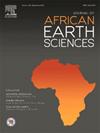Zircon trace element geochemistry of the neoarchaean late-granite suites along the southern margin of the Zimbabwe craton, Zimbabwe
IF 2.2
4区 地球科学
Q2 GEOSCIENCES, MULTIDISCIPLINARY
引用次数: 0
Abstract
In-situ laser ablation quadrupole inductively coupled plasma mass spectrometry (LA-Q-ICP-MS) analyses of zircon grains from the ca. 2635–2620 Ma Chilimanzi and Razi granite suites along the southern margin of the Zimbabwe Craton in Zimbabwe reveal that a majority of zircons experienced post-magmatic chemical alteration. A minority (5 %) of the analyses show unaltered (Type-1) patterns. Type-1 zircons show low abundances of light rare earth elements (LREE) relative to heavy rare earth elements (HREE) and they preserve igneous zoning textures. The majority of the grains analysed exhibit altered (Type-2) patterns indicated by overabundance in LREE concentrations and such grains are partially or completely metamict (radiation damaged). Type-2 grains experienced radiation damage due to high initial contents of radioactive elements including U and Th incorporated at the time of crystallization. The structurally defective zircons experienced pervasive chemical alteration from Type-1 to Type-2 compositions via susceptible regions such as fractures under fluid-mediated conditions. Lack of analyses with Th/U ≤ 0.08, which is a diagnostic feature of zircons precipitated from hydrothermal-melts supports the view that Type-2 compositions derived from alteration of Type-1 zircons. LREE overabundance in the zircon suites is also explained by inadvertent analysis of mineral inclusions and/or contaminants such as Fe, Ti, and Mn oxides along fractures.
Our study established a LREE index, LREE-I = 32 as a discriminant for altered and unaltered zircon analyses. LREE-I < 32 (altered compositions) correlates with known alteration features such as cathodoluminescence dark core domains, partial or complete overprint of igneous textures in fluid-mediated conditions, overabundance in LREE, and high contents of non-structural elements in zircon such as Ti, Li, Th and U. The Ti-in-zircon thermometry on unaltered analyses of the Chilimanzi Suite's Great Zimbabwe granite constrains the crystallization temperature at 698–738 °C, consistent with temperatures at zircon saturation for felsic magmas. Our study emphasizes that zircon chemistry is a pre-requisite data layer that should be incorporated in analytical protocols to complement conventional, discordance-based data filter for effective screening of U-Pb analyses for age determinations.
求助全文
约1分钟内获得全文
求助全文
来源期刊

Journal of African Earth Sciences
地学-地球科学综合
CiteScore
4.70
自引率
4.30%
发文量
240
审稿时长
12 months
期刊介绍:
The Journal of African Earth Sciences sees itself as the prime geological journal for all aspects of the Earth Sciences about the African plate. Papers dealing with peripheral areas are welcome if they demonstrate a tight link with Africa.
The Journal publishes high quality, peer-reviewed scientific papers. It is devoted primarily to research papers but short communications relating to new developments of broad interest, reviews and book reviews will also be considered. Papers must have international appeal and should present work of more regional than local significance and dealing with well identified and justified scientific questions. Specialised technical papers, analytical or exploration reports must be avoided. Papers on applied geology should preferably be linked to such core disciplines and must be addressed to a more general geoscientific audience.
 求助内容:
求助内容: 应助结果提醒方式:
应助结果提醒方式:


